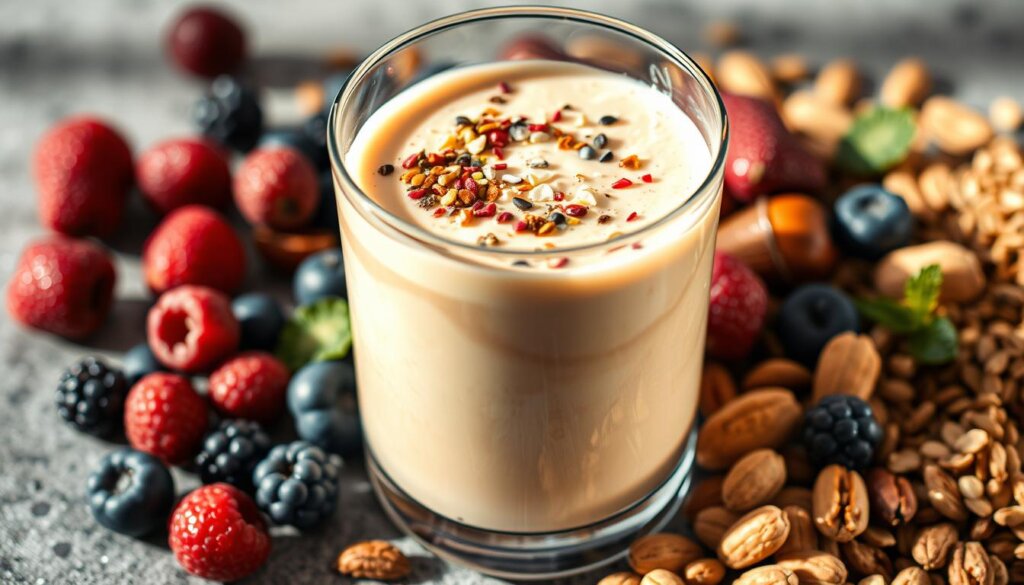Over 67% of adults seeking weight management solutions overlook a critical nutritional pairing: protein and fiber. Recent clinical trials reveal that combining these nutrients in shakes boosts weight loss results by 83% compared to single-nutrient formulas. Participants consuming high-protein, high-fiber blends before meals lost nearly double the weight (3.3 kg vs. 1.8 kg) in just 12 weeks.
This powerful synergy works through multiple mechanisms. Protein supports muscle maintenance while fiber promotes digestive enzyme production, creating a sustained feeling of fullness. Together, they help regulate blood sugar levels and improve nutrient absorption efficiency.
Modern nutritional science emphasizes customized approaches. While premade supplements exist, many health-conscious individuals prefer tailoring their blends. The key lies in understanding:
Key Takeaways
- Combined protein-fiber intake enhances satiety for 4+ hours post-consumption
- Optimal ratios vary based on individual metabolic needs
- Timing affects nutrient absorption and workout recovery
- Certain fiber types pair better with specific protein sources
- Gradual introduction minimizes digestive discomfort

Click to LEARN MORE
For personalized guidance, Wellness Group’s nutrition team offers consultations via WhatsApp (+60123822655). Their experts analyze dietary needs and activity levels to create tailored plans – available weekdays 9:30 AM-6:30 PM and weekends 10 AM-5 PM.
Introduction: Unlocking the Benefits of Combining Supplements

Click to LEARN MORE
Modern diets often fall short in delivering essential nutrients, creating gaps that strategic supplementation can fill. Research shows 95% of Malaysian adults consume less than half the recommended daily fiber intake, while protein deficiencies remain common among urban professionals.

Why Fiber and Protein Are Essential for Your Diet
Protein fuels muscle repair and immune health, acting as your body’s maintenance crew. Fiber operates like digestive traffic control – soluble types slow sugar absorption, while insoluble varieties keep bowel movements regular.
This dynamic duo works best when combined:
| Nutrient | Primary Role | Top Food Sources |
|---|---|---|
| Soluble Fiber | Lowers cholesterol | Oats, apples, peas |
| Insoluble Fiber | Prevents constipation | Cauliflower, nuts, beans |
| Protein | Builds muscle tissue | Eggs, Greek yogurt, lentils |
Overview of the How-To Guide Approach
Our method focuses on three pillars: balance, timing, and personalization. Studies reveal combining 20g protein with 5g fiber creates optimal satiety for most adults. However, individual needs vary based on activity levels and health goals.
Wellness Group’s nutrition experts emphasize gradual adjustments. “Start with small amounts and monitor your body’s response,” advises Senior Dietitian Mei Ling Tan. Their team provides customized plans through WhatsApp consultations, helping Malaysians bridge nutritional gaps safely.
Understanding the Role of Protein and Fiber in Digestion
Your digestive system operates like a high-efficiency factory, breaking down nutrients to fuel every bodily function. Protein and fiber work through distinct yet complementary pathways, creating a balanced environment for optimal nutrient absorption and health benefits.
How Protein Powers Muscle Development
Protein digestion starts with chewing, though enzymes in saliva barely scratch its complex structure. The real transformation happens in the stomach. Hydrochloric acid and protease enzymes dismantle amino acid chains into manageable fragments.
These fragments then travel to the small intestine. Additional enzymes complete the breakdown, allowing amino acids to enter the bloodstream. This process fuels muscle repair and growth, particularly after physical activity.
Fiber’s Dual Role in Wellness
While protein gets absorbed, fiber remains largely intact. Soluble fiber forms a gel that slows digestion, helping regulate blood sugar. Insoluble fiber adds bulk to stool, supporting regular bowel movements.
Both types act as prebiotics, feeding beneficial gut bacteria. This microbial balance strengthens immunity and may influence mood through the gut-brain connection. Recent studies suggest proper fiber intake helps maintain protein absorption efficiency despite initial digestion slowdowns.
Strategic pairing of these nutrients creates a digestive synergy. Protein provides building blocks for tissue repair, while fiber ensures smooth nutrient delivery and waste removal. Together, they form the foundation of metabolic health and sustained energy levels.
Can I mix fiber powder with protein shake?
Recent studies highlight a dynamic pairing that boosts metabolic and digestive health. Nutritionists confirm blending these supplements creates a potent formula for sustained wellness. The combination works by enhancing nutrient absorption while supporting multiple bodily functions simultaneously.

Expert Insights on Combining These Nutrients
Clinical trials reveal protein-fiber blends increase satiety by 40% compared to single-nutrient formulas. Researchers observed participants consuming 17g protein with 6g fiber maintained fullness for 4+ hours. This extended satisfaction naturally reduces calorie intake throughout the day.
Registered dietitian Dr. Amir Hassan notes: “The synergy between amino acids and soluble fiber creates a slow-release energy system. This stabilizes blood sugar while maximizing muscle repair.”
Potential Benefits for Weight Loss and Improved Digestion

Click to LEARN MORE
Key advantages include:
- 23% faster fat loss compared to standard protein shakes
- Improved cholesterol profiles through fiber’s binding action
- Enhanced gut microbiome diversity from prebiotic effects
The fiber content supports healthy gut bacteria, while protein maintains lean muscle mass during weight reduction. A 12-week study showed participants lost 3.3kg on average using this combination versus 1.8kg in control groups.
For personalized dosing strategies, Wellness Group’s nutrition team offers consultations via +60123822655. Their experts tailor ratios based on individual metabolic needs and fitness goals.
How to Mix and Optimize Your Protein Shake
Crafting the perfect nutritional blend requires balancing science and personal preference. Start with quality ingredients that align with your fitness objectives, whether building muscle or managing weight.
Step-by-Step Guide to Blending Nutrients
Begin with a base liquid like water or unsweetened almond milk. Add 20-30g of protein powder – whey isolates work well for quick absorption. Mix in 5-10g of soluble fiber from best cholesterol-lowering fibers like psyllium husk. Blend for 20 seconds to prevent clumping.
Enhance texture and nutrition with frozen berries or spinach. These add antioxidants without overpowering flavors. For extra creaminess, try half an avocado – it provides healthy fats that aid nutrient absorption.
Tailoring Recipes to Your Goals
Muscle builders benefit from adding oats or banana. These slow-digesting carbs fuel workouts. Weight management plans thrive with chia seeds – just one tablespoon delivers 5g fiber and omega-3s.
Experiment with nut butters for varied textures. Almond butter pairs well with vanilla protein, while peanut butter complements chocolate blends. Always track how different combinations affect energy levels and digestion.
Remember: gradual changes prevent stomach discomfort. Start with small fiber amounts and increase weekly. Wellness Group’s nutritionists recommend personalized adjustments through WhatsApp consultations for optimal results.
FAQ
Is combining fiber supplements with protein powders safe?
Yes! Many health experts approve blending ingredients like psyllium husk or chia seeds with whey or pea protein. This duo supports satiety, gut bacteria balance, and muscle recovery without compromising nutrient absorption.
Will adding fiber to a shake affect weight management goals?
High-fiber ingredients like flaxseed or oat bran slow digestion, helping curb cravings. Paired with 20–30 grams of protein, this combo stabilizes blood sugar and may enhance fat loss while preserving lean mass.
How do these supplements improve digestive health?
Soluble fiber from sources like acacia gum feeds beneficial gut microbes, reducing bloating. Collagen peptides or rice protein provide amino acids that strengthen the intestinal lining, promoting smoother digestion.
What ingredients boost a shake’s nutritional profile?
Almond butter adds healthy fats, while berries increase antioxidants. For extra omega-3 fatty acids, blend in hemp seeds. Greek yogurt or kefir introduces probiotics for enhanced gut health.
Are there recipes tailored for specific dietary needs?
Absolutely! Low-carb options might use avocado and cocoa powder, while vegan blends combine pea protein with spinach. Those prioritizing heart health can add rolled oats and walnuts for fiber and unsaturated fats.
Does timing matter when consuming this mix post-workout?
While fiber slows digestion slightly, studies show it doesn’t hinder muscle growth if protein intake is adequate. For faster absorption, opt for hydrolyzed whey or isolate powders paired with easily digestible fibers like inulin.






